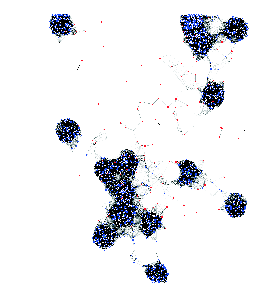| |
 Description: Description:
Mobile Ad Hoc Networks (MANETs) are composed of a set of
communicating devices which are able to spontaneously interconnect
without any pre-existing infrastructure. In such kind of networks,
broadcasting becomes an operation of capital importance for the
own existence and operation of the network. Hence, MANETs are highly
fluctuating networks since they are composed of
mobile devices, and both the localization and the number of these
devices are continuously changing along time.
This dynamic and unpredictable behavior
of the MANETs represents one of the main obstacles for
making efficient communications.
Optimizing a broadcasting strategy in MANETs [ALB2005] [LUN2006] is a multiobjective problem
targeting three goals: reaching as many devices as possible,
minimizing the network utilization,
and reducing the duration time
of the broadcasting process.
Complexity:
Optimizing the broadcasting protocol for MANETs networks supposes a
very complex problem
because of the own features of this kind of networks.
Due to the highly fluctuating nature
of these networks, the evaluation function
is stochastic, making necessary multiple
executions of the simulator for
evaluating the protocol. In addition, every time we
execute the simulator the
protocol is evaluated on a different network, since we are
working with a
problems generator. Finally, the problem is easily scalable just by adding more
devices to the simulation area.
Metropolitan MANETs
- High Density Areas (HDA): areas with high station density
- HDAs can appear and disappear from the network
Optimization Problem
- Fine-tune of a broadcasting strategy called DFCN
(Delayed Flooding with Cumulative Neighborhood)
- Target: metropolitan MANETs
|
 Figure 1: Example of MANET
Figure 1: Example of MANET
|
|
|
| |
 Related Papers: Related Papers:
[ALB2005] E. Alba, P. Bouvry, B. Dorronsoro, F. Luna, A.J. Nebro, A Cellular Multi-Objective
Genetic Algorithm for Optimal Broadcasting Strategy in Metropolitan MANETs, en IPDPS-NIDISC,
p. 192b. (2005).
[LUN2006] F. Luna, A. J. Nebro, B. Dorronsoro, E. Alba, P. Bouvry, L. Hogie, Optimal Broadcasting in
Metropolitan MANETs Using Multiobjective Scatter Search, Applications of Evolutionary Computing:
EvoCOMNET 2006, in LNCS EvoWorkshops06,
Springer-Verlag, pp. 255 - 266, 2006.
Click here to get the bibliography in bibtex format.
|
|





















 Description:
Description: Figure 1: Example of MANET
Figure 1: Example of MANET